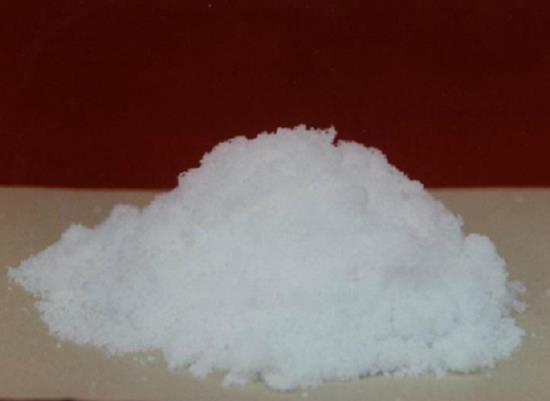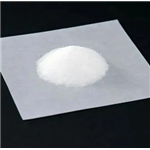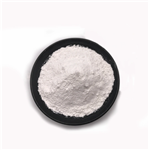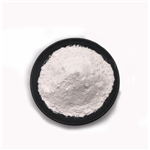Sodium thiocyanate: pharmacological activity and toxicity
Jun 28,2023
General Description
Sodium thiocyanate has various pharmacological activities. It can modulate myeloperoxidase (MPO) activity, potentially reducing tissue destruction caused by MPO-associated oxidative damage. Sodium thiocyanate supplementation has been studied in conditions like ulcerative colitis and atherosclerosis, showing positive effects on HOSCN formation and reducing atherosclerotic plaque size. In muscle, sodium thiocyanate enhances the excitation-contraction coupling mechanism and amplifies the response to certain substances. However, it's important to note that sodium thiocyanate can be toxic, causing gastrointestinal, neurologic, and cardiovascular effects. Supportive treatment is generally used for toxicity cases. Further research is needed to explore its mechanisms and potential applications.

Figure 1. Sodium thiocyanate
Pharmacological activity
Modulating MPO
Sodium thiocyanate plays a role in modulating MPO activity towards a hypothiocyanous acid (HOSCN)-specific pathway. In conditions like ulcerative colitis, where leukocyte infiltration and oxidative damage are present, sodium thiocyanate supplementation can increase HOSCN formation. HOSCN primarily targets low-molecular weight protein thiols, potentially reducing MPO-associated tissue destruction. In a study using a model of acute colitis, mice supplemented with sodium thiocyanate showed increased fecal and plasma sodium thiocyanate levels. However, the supplementation did not alter weight loss, clinical score, mucin levels, crypt integrity, cellular infiltration, or neutrophil recruitment compared to chloride supplementation. These findings suggest that sodium thiocyanate administration can influence MPO activity. 1
Improving atherosclerotic
Sodium thiocyanate can modulate the formation of reactive oxygen species (ROS) by MPO, an enzyme involved in atherosclerotic plaque formation. In this study, sodium thiocyanate treatment was investigated for its effects on atherogenesis in mice. Apolipoprotein E knockout (ApoE-/-) mice on a western diet were treated with sodium thiocyanate for 8 weeks. The results showed that sodium thiocyanate treatment reduced the size of atherosclerotic plaques in the aortic roots. It also decreased oxidative damage and improved endothelial function. Furthermore, Sodium thiocyanate inhibited neointima formation following arterial injury. Monocyte and neutrophil infiltration did not show significant changes upon sodium thiocyanate treatment. Serum levels of the pro-inflammatory cytokine IL-6 decreased, while the anti-inflammatory cytokine IL-10 increased after sodium thiocyanate treatment. Overall, sodium thiocyanate exhibited beneficial effects on different stages of atherosclerotic plaque development in mice. 2
Regulateing muscle state
A study investigated the impact of sodium thiocyanate on the excitation-contraction coupling mechanism in the mouse soleus muscle. To do so, a combination of electrical and pharmacological stimulation was employed. The findings revealed that sodium thiocyanate had several effects on muscle function. Firstly, sodium thiocyanate was found to prolong the "active state" following electrical stimulation. This means that the muscle remained in an activated state for a longer duration after being stimulated. This suggests that sodium thiocyanate may enhance the contractile response of the muscle. Additionally, sodium thiocyanate was observed to enhance the response of the muscle to two specific substances: caffeine and KCl. At concentrations of 8 mM caffeine and 80 mM KCl, the response of the muscle was amplified in the presence of sodium thiocyanate. This indicates that sodium thiocyanate can potentiate the effects of these compounds on muscle contraction. Overall, the study highlights the influence of sodium thiocyanate on the excitation-contraction coupling mechanism in the mouse soleus muscle. It suggests that sodium thiocyanate can extend the active state of the muscle and enhance its response to certain stimulants. Further research is needed to fully understand the underlying mechanisms and potential applications of these findings. 3
Toxicity
Thiocyanate can cause gastrointestinal, neurologic, and cardiovascular toxicity. It interferes with several laboratory assays, leading to inaccurate results. In cases of acute thiocyanate toxicity, symptoms may include delirium, tachycardia, seizure activity, lactatemia, acidemia, and narrowing of the arterio-venous oxygen gradient. Treatment options for thiocyanate toxicity are supportive, and in severe cases, hemodialysis may be considered to remove thiocyanate from the blood. Lipid emulsion therapy (LET) has been used in some cases based on thiocyanate's lipophilicity, but further research is needed to determine its effectiveness. Cyanide antidotal treatment may be considered if there is evidence of in vivo conversion to cyanide, although it was not administered in the case mentioned. Thiocyanate has a half-life of approximately 61.6 hours and is eliminated via first-order kinetics. 4
Reference
1. Liu Y, Burton T, Rayner BS, et al. The role of sodium thiocyanate supplementation during dextran sodium sulphate-stimulated experimental colitis. Arch Biochem Biophys, 2020, 692:108490.
2. Zietzer A, Niepmann ST, Camara B, et al. Sodium thiocyanate treatment attenuates atherosclerotic plaque formation and improves endothelial regeneration in mice. PLoS One, 2019, 14(4):e0214476.
3. Moulds RF. A comparison of the effects of sodium thiocyanate and dantrolene sodium on a mammalian isolated skeletal muscle. Br J Pharmacol, 1977, 59(1):129-133.
4. Watson CJ, Overbeek DL, Allegri-Machado G, et al. Thiocyanate toxicity: a teaching case. Clin Toxicol (Phila), 2022, 60(7):876-881.
- Related articles
- Related Qustion
- Sodium Thiocyanate: A Comprehensive Guide for Chemical Industry Professionals Apr 30, 2024
Sodium thiocyanate is a significant chemical in the industrial landscape, marked by its versatile applications and critical role in synthesis processes.
- Understanding the Diverse Applications and Potential Hazards of Sodium Thiocyanate Jan 3, 2024
Sodium thiocyanate is a white crystalline powder and highly soluble in water, ethanol, and acetone. It has various industrial applications but poses health risks and environmental hazards.
- Sodium thiocyanate-Application Dec 12, 2019
Sodium thiocyanate is the chemical compound with the formula NaSCN. This colorless deliquescent salt is one of the main sources of the thiocyanate anion.
TMSOTf is a trifluoromethanesulfonate compound with a trimethylsilyl R-group. It is commonly used in organic synthesis and has similar reactivity to trimethylsilyl chloride....
Jun 28,2023APIPhosphoric acid tris(2-chloro-1-methylethyl) ester is a commonly used organophosphate compound, but studies have shown that it may cause adverse health effects.....
Jun 29,2023APISodium thiocyanate
540-72-7You may like
Sodium thiocyanate manufacturers
- Sodium thiocyanate
-

- $13.00 / 1kg
- 2024-05-10
- CAS:540-72-7
- Min. Order: 1kg
- Purity: 99%
- Supply Ability: 300tons
- Sodium thiocyanate
-

- $520.00 / 1ton
- 2024-05-10
- CAS:540-72-7
- Min. Order: 5ton
- Purity: 99%
- Supply Ability: 300tons
- Sodium thiocyanate
-

- $350.00 / 1ton
- 2024-05-10
- CAS:540-72-7
- Min. Order: 10ton
- Purity: 99%
- Supply Ability: 3000tons




